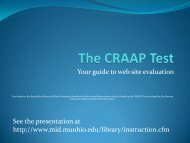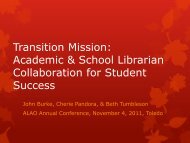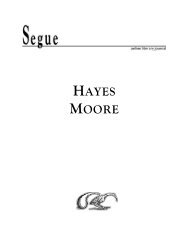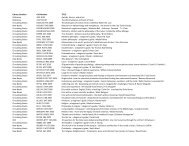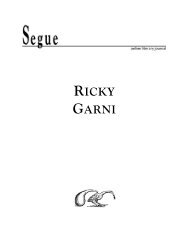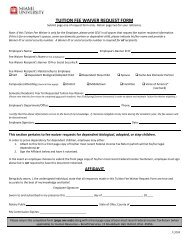Bibliography of Assessment Alternatives: Portfolios
Bibliography of Assessment Alternatives: Portfolios
Bibliography of Assessment Alternatives: Portfolios
Create successful ePaper yourself
Turn your PDF publications into a flip-book with our unique Google optimized e-Paper software.
Culham, Ruth E. Alternative <strong>Assessment</strong>: <strong>Portfolios</strong> from the Inside Out, 1996. Available<br />
from: Northwest Regional Educational Laboratory, 101 SW Main St., Suite 500,<br />
Portland, OR 97204, (503) 275-9500, fax: (503) 275-0450, e-mail: culhamr@nwrel.org<br />
You can't recommend that someone else (e.g., students) do a portfolio until you've tried one<br />
yourself. This paper describes how to create a continuing teacher portfolio as a means both<br />
to explore the portfolio process and to improve instruction by reflecting on past practice.<br />
(AL# 130.4ALTASP)<br />
Darling-Hammond, Linda, and Jacqueline Ancess. Graduation by Portfolio at Central Park<br />
East Secondary School, December 1994. Available from: The National Center for<br />
Restructuring Education, Schools, and Teaching (NCREST), Box 110, Teachers<br />
College, Columbia University, New York, NY 10027, fax: (212) 678-4170.<br />
The authors describe the philosophy behind their graduation portfolio, the skills and habits <strong>of</strong><br />
mind that undergrid all aspects <strong>of</strong> education at Central Park East Secondary School (and are<br />
specifically demonstrated by the portfolios), the manner in which the school was restructured<br />
to support its goals for students, specific requirements <strong>of</strong> the portfolio, and sample portfolio<br />
entries.<br />
The portfolio has 14 elements that involve demonstration <strong>of</strong> academic knowledge and skills<br />
(science, mathematics, social studies, etc.), but also things like research skills, community<br />
service, and ability to reason about social issues. Types <strong>of</strong> entries are specified, but students<br />
have much leeway in pursuing activities in their own way. Different parts <strong>of</strong> the portfolio are<br />
evaluated in various ways, including judgments <strong>of</strong> oral presentations, and written/visual<br />
products. Scoring guides emphasize understanding, connections, use <strong>of</strong> evidence, voice, and<br />
conventions.<br />
The authors address important assessment balancing acts such as balancing “standards”<br />
against “standardization,” balancing objectivity against subjectivity <strong>of</strong> judgments, and<br />
balancing efficiency against ideal practice.<br />
(AL# 000.3GRAPOC)<br />
Daws, Donald. Schoolwide <strong>Portfolios</strong>. Located in: Student <strong>Portfolios</strong>, 1993, pp. 33-45.<br />
Available from: National Education Association (NEA) Pr<strong>of</strong>essional Library,<br />
PO Box 509, West Haven, CT 06516, (800) 229-4200.<br />
This paper describes a cross-disciplinary portfolio system developed at an alternative high<br />
school. The paper: (1) includes a description <strong>of</strong> the steps the teachers went through to learn<br />
about and develop their system; (2) provides sound advice for portfolio implementors, (3) has<br />
complete statements <strong>of</strong> their definitions and rationale for portfolios, logistics, and the goals to<br />
be documented in the portfolio; (4) explains the necessity to treat portfolios as any other<br />
<strong>Assessment</strong> Resource Library, (503) 275-9582 21 Portfolio <strong>Bibliography</strong><br />
(formerly Test Center) NWREL, December 1996




